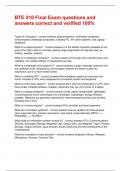BTE 210 Final Exam questions and
answers correct and verified 100%
Types of Computers - correct answers-supercomputers, mainframe computers,
minicomputers (midrange computers), Desktop PC, thin client systems, and Laptop +
Notebook
What is a supercomputer? - correct answers-It is the fastest computer available at any
given time; high costs so normally used by large organization for big data sets, ex:
military, weather, science
What is a mainframe computer? - correct answers-At the high end of performance and
reliability; can handle millions of transactions per day
What is a midrange (minicomputer)? - correct answers-Larger midrange computer that
are relatively small, inexpensive, and compact; perform the same function as
mainframe, but to a more limited extent
What is a desktop PC? - correct answers-Microcomputer system for business and
home, includes a CPU and a separate but connected monitor and keyboard
What is a thin-client system? - correct answers-don't offer full functionality of a PC, don't
have locally installed software, cheaper, physically they are very similar to a laptop
What is a laptop/notebook? - correct answers-small, easily transportable, lightweight
microcomputers that fit comfortably into a briefcase. Lightweight, energy-efficient,
portable. Netbooks are generally optimized for Internet-based services such as Web
browsing and e-mail.
What is a microcomputer? - correct answers-PCs, smallest and least expensive
What are information systems? - correct answers-Can be divided into three phases -
input (input devices), process (processor), and output (output devices) INPUT —>
PROCESS —> OUTPUT
What does an information system consist of? - correct answers-CPU, Communications
Devices, Secondary Storage (Magnetic Disk, Optical Disk, and Magnetic Tape), Primary
Storage, Output Devices, Input Devices, Buses (wires that connect components of the
motherboard)
What are examples of input devices? - correct answers-Keyboard, Mouse, Webcam,
Microphone, Scanner, Numeric Pad
,What are examples of output devices? - correct answers-Printers, Video display, audio
output, plotter (large-format printer)
What are the main components of a computer? - correct answers-System Fan, Power
Supply, Motherboard, CPU, Ram Modules, Optical Drive, Hard Drive, Heat Sink, Floppy
What is the CPU (Central Processing Unit)? - correct answers--Manipulates the data
and control the tasks performed by the other components
-The "brain" of the computer system is called the "central processing unit
What does the CPU consist of? - correct answers-Arithmetic Logic Unit (ALU)-simple
math and logic: comparison
Control Unit (CU)- controls all computer parts
Cache Memory- registers on cache are where computation takes place
What is the primary storage? - correct answers-It temporarily stores data and program
instructions during processing; RAM, ROM software operates here
Types of primary memory (main memory) - correct answers-register memory - part of
the CPU. Has the least capacity and stores data only immediately before and after
processing. located closer to CPU than the RAM
cache memory - High speed memory that enables the computer to temporarily store
blocks of data that are used more frequently
random access memory (RAM) - holds a software program and small amounts of data
for processing
read only memory (ROM) - type of chip where certain critical instructions are held and
retains these instructions even when the computer is off MANUFACTURER INSTALLS
THIS
Types of secondary storage - correct answers-Magnetic tape - on a large open reel or in
a smaller cartridge or cassette
, magnetic discs - most widely used
solid state drives (SSD) - serve the same purpose as a hard drive and store data in
memory chips, but do not have moving parts
Optical storage devices - laser reads the surface of a reflective plastic platter
Flash memory (memory cards) - nonvolatile electronic storage devices with no moving
parts and use 30x less battery power than hard drives
SSD vs. HDD - correct answers-SSD no moving parts (less likely to break ) - Faster
than HDD - more expensive - lighter - run cooler than HDD , lower power consumption
than HDD.
What are communication devices? - correct answers-Bluetooth, etc.
What is a heat sink? - correct answers-A specially designed piece of metal that draws
heat away from the CPU.
What are RAM modules? - correct answers-They are on the motherboard in either 8 GB
or 16 GB configuration
What is RAM (Random Access Memory)? - correct answers-The hardware in a
computing device where the operating system (OS), application programs and data in
current use are kept so they can be quickly reached by the device's processor
What is ROM (Read Only Memory)? - correct answers-memory chips that cannot be
written to or erased and contains information supplied by the manufacturer
What is the secondary storage? - correct answers-It stores data and programs for future
use; where data is stored (magnetic disk, optical disk, magnetic tape), spins clockwise
and counter clock wise and magnetic arms expands and contracts looking for files
What is a bit? - correct answers-The smallest unit of information consisting of either a 1
or a 0, on/off switch
How many bits are in a byte? - correct answers-8
What is a byte? - correct answers-a group of 8 bits; SMALLEST ADDRESSABLE UNIT
OF DATA
Who created the binary alphabet? - correct answers-ASCII
Conversions of bytes and bits - correct answers-1 byte = 8 bits
1024 bytes = 1 kilobyte




